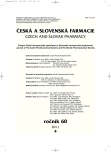The influence of PVA on the size of oligoester nanoparticles prepared by the emulsion solvent distribution method
Authors:
Eva Valentová; Eva Šnejdrová; Milan Dittrich
Authors‘ workplace:
Univerzita Karlova v Praze, Farmaceutická fakulta v Hradci Králové, Katedra farmaceutické technologie
Published in:
Čes. slov. Farm., 2011; 60, 193-199
Category:
Original Articles
Overview
Nanoparticles of poly(DL-lactic acid) (PDLLA) were prepared by the emulsion solvent distribution method. The external aqueous phase was composed of 1.5 and 3.0% solutions of three kinds of low molecular weight polyvinylalcohol (PVA) varying in molecular weight and saponification degree. The internal oil phase was made from a 1% solution of PDLLA dissolved in dichloromethane, chloroform and a mixture of these two solvents. Viscosity and surface tension of these phases were not significantly influenced by the selected solvent or solute quality. Contrary to these results, very different values of nanoparticle size were measured by the PCS method and the values of the zeta potential quantified by a laser Doppler velocimeter. ANOVA method revealed PDLLA solvent quality and PVA type as a significant factors for particle size, while PVA type and its concentration were factors relevant for zeta potential changes. The formation of nanoparticles was not controlled by the mechanism of the pure emulsification process characterised by the Weber number. To a great extent, this process was influenced by solidification and mutual mixing of phases. PVA content variables in nanoparticles were indicative of the hypothesis of a small influence of coalescence on nanoparticles formation.
Key words:
PDLLA nanoparticles – emulsion method of evaporation and separation of solvent – size and potential of nanoparticles
Sources
1. Fahlman, B. D.: Materials Chemistry. New York: Springer-Verlag 2007; 1, 282–283.
2. Kreuter, J.: Nanoparticles as drug delivery system. In: Nalwa HS, editor. Encyclopedia of nanoscience and nanotechnology. New York: American Scientific Publishers 2004; 7, 161–180.
3. Salata, O. V.: Applications of nanoparticles in biology and medicine. Journal of Nanobiotechnology 2004; 2, 1–6.
4. Breunig, M., Bauer, S., Goepferich, A.: Polymers and nanoparticles: Intelligent tools for intracellular targeting? European Journal of Pharmaceutics and Biopharmaceutics 2008; 68, 112–128.
5. Allémann, E., Gurny, R., Doelker, E.: Drug-loaded nanoparticles – preparation methods and drug targeting issues. European Journal of Pharmaceutics and Biopharmaceutics 1993; 39, 173–191.
6. Gopal, E. S. R.: Principles of emulsion formation. In: Sherman P, editor. Emulsion Science. New York: Academic Press 1968; 1–75.
7. Walstra, P.: Formation of emulsions. In: Becher P, editor. Encyclopedia of emulsion technology. Basic theory. New York: Marcel Dekker 1983; 1, 57–127.
8. Gordon, C., Smith, K.: Impact of Weber number on the behavior of an impinging water droplet; 2006. Available: http://www.math.arizona.edu/~ksmith/LAB2006.pdf via the INTERNET. Accessed 2010 Jun 10.
9. Richard, D., Quere, D.: Bouncing water droplets. Europhysical Letters 2000; 50, 769–755.
10. Shinnar, R.: On the behaviour of liquid dispersions in mixing vessels. Journal of Fluid Mechanics 1961; 10, 259–275.
11. Madani, K., Friberg, S. E.: Van der Waals interactions in three-phase emulsions. Progress in Colloid Polymer Science 1978; 65, 164–171.
12. Li, J. K., Wang, N. M., Wu, X. S.: Poly(vinylalcohol) nanoparticles prepared by freezing-thawing process for protein/peptide drug delivery. Journal of Controlled Release 1998; 56, 117–126.
13. Feczkó, T., Tóth, J., Gyenis, J.: Comparison of the preparation of PLGA-BSA nano- and microparticles by PVA, poloxamer and PVP. Colloids and Surfaces A: Physicochemical and Engineering Aspects 2007; 319, 188–195.
14. Murakami, H., Kawashima, Y., Niwa, T., Hino, T., Takeuchi, H., Kobyashi, M.: Influence of the degree of hydrolyzation and polymerization of poly(vinylalcohol) on the preparation and properties of poly(DL-lactide-co-glycolide) nanoparticle. International Journal of Pharmaceutics 1997; 149, 43–49.
15. Sahoo, S. K., Panyam, J., Prabha, S., Labhasetwar, V.: Residual polyvinyl alcohol associated with poly(D,L-lactide-co-glycolide) nanoparticles affects their physical properties and cellular uptake. Journal of Controlled Release 2002; 82, 105–114.
16. Tao, J.: Effects of molecular weight and solution concentration on electrospinning of PVA [dissertation]. Worchester (United Kingdom): Worchester Polytechnic Institute 2003; 96 p. edt-0613103-130015.
17. Zwick, M. M.: The blue complexes of iodine with poly(vinylalcohol) and amylose. Journal of Polymer Science 1966; 4, 1642–1644.
18. Lee, S. Ch., Oh, J. T., Jang, M., Chung, S. I.: Quantitative analysis of polyvinyl alcohol on the surface of poly(lactide-co-glycolide) microparticles prepared by solvent evaporation method: effect of particle size and PVA concentration. Journal of Controlled Release 1998; 59, 123–132.
19. Modaress, H., Nia, M. M., Mostafa, R.: Viscosity measurements and modelling of aqueous polyvinyl alcohol mixtures. Iranian Polymer Journal 2005; 14, 181–184.
20. Misra, G. S., Mukherjee, P. K.: The relation between the molecular weight and intrinsic viscosity of polyvinyl alcohol. Colloid & Polymer Science 1980; 258, 1435–1536.
21. Grishpun, V., Rudin, A.: Measurement of Mark-Houwink constants by size exclusion chromatography with a low angle laser light scattering detector. Die Makromolekulare Chemie, Rapid Communications 1985; 6, 219–223.
22. Ray, A. M., Vert, M., Gautier, J. C., BenoĒt, J. P.: Fate of [14 C] poly(DL-lactide-co-glycolide) nanoparticles after intravenous and oral administration to mice. International Journal of Pharmaceutics 1994; 106, 201–211.
23. Zambaux, M. F., Bonneaux, F., Gref, R., Maincent, P., Dellacherie, E., Alonso, M. J., Labrude, P., Vigneron, C.: Influence of experimental parameters on the characteristics of poly(lactic acid) nanoparticles prepared by a double emulsion method. Journal of Controlled Release 1998; 50, 31–40.
24. Mallet, A. S., Craig, R. L.: The effect of molecular weight of sodium polyacrylate on pigment dispersion. Tappi 1977; 60, 101–104.
Labels
Pharmacy Clinical pharmacologyArticle was published in
Czech and Slovak Pharmacy

2011 Issue 4
Most read in this issue
- On the history of pharmaceutical industry in the Czech Lands. INTERPHARMA
- Antagonists of angiotensin AT1 receptors
- Clinical significance of cytochrome P450 genetic polymorphism – part II. Cytochrome P450 2C9
- Antiphlogistic hydrogels based on the white lily
